 W
WAbbot's Tower is a late-16th-century tower house situated near New Abbey, Dumfries and Galloway, Scotland, that was built by the Abbot of Sweetheart Abbey. The building was restored in the early 1990s and is now used as a private residence and as a bed and breakfast. This structure should not be confused with the Abbot's Tower of Alnwick Castle.
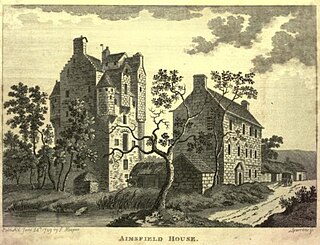 W
WAmisfield Tower is a well-preserved tower house near Tinwald, about 5 miles (8.0 km) north of Dumfries, in Dumfries and Galloway, south-west Scotland. The castle has also been known as Hempisfield Tower. It is a Category A listed building.
 W
WAuchen Castle is a ruined 13th-century quadrangular castle situated near Moffat, Dumfries and Galloway. It was designated as a scheduled ancient monument in 1937.
 W
WAuchen Castle is an exclusive hire wedding destination in Moffat, Dumfries and Galloway, Scotland. With 26 bedrooms, a private lake and falconry school, it has a 5-star rating by the Scottish tourist board. The castle has hosted celebrity guests such as the Beatles, Barbara Cartland, Margaret Thatcher and the King of Norway, and is a wedding venue which has attracted several celebrity weddings in recent years.
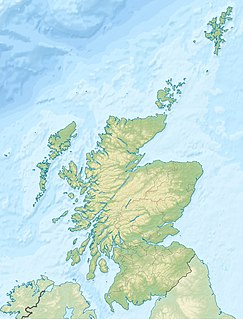 W
WAuchenrivock Tower is a ruined late 16th century tower house situated near Langholm, Dumfries and Galloway. The remains of the tower, which rise 8 feet at their highest, are currently built into a garden wall.
 W
WAuchenskeoch Tower is a 17th-century tower house situated in Dumfries and Galloway, south-west Scotland. It is near Dalbeattie in the civil parish of Colvend and Southwick, in the county of Kirkcudbrightshire. It is thought to be built on a Z-plan, making it the only such tower in Galloway. Dalswinton Tower in the neighbouring county of Dumfriesshire is the only other example in Dumfries and Galloway. The remains of the tower are within the modern Castle Farm and are a scheduled ancient monument.
 W
WBalmangan Tower is a ruined 16th-century tower house situated near Borgue, Dumfries and Galloway.
 W
WBarclosh Castle is a ruined 16th-century tower house situated near Dalbeattie, Dumfries and Galloway. There remains a section of wall 4 feet thick and 27 feet high.
 W
WBarholm Castle is a tower house located five miles south-west of Gatehouse of Fleet, in Kirkcudbrightshire, Galloway, Scotland. The tower dates back to the late 15th century, and it was a stronghold of a branch of the MacCulloch family. The present form of the castle dates from rebuilding in the 16th or 17th century, and in the early 2000s it was restored from a roofless state to residential use. The tower is sometimes identified with the fictional Ellangowan, in Sir Walter Scott's Guy Mannering.
 W
WBarscobe Castle is a 17th-century tower house in Balmaclellan, Kirkcudbrightshire, Scotland. It is a typical house of a country laird, and according to a panel above the entrance, was built in 1648. The L-plan tower was constructed using stone taken from Threave Castle. The main block is three storeys high with the stair wing one storey higher. The gables have a modification of crowsteps found only in Galloway. It is a fine example of a mid-17th-century house which was unoccupied for many years until 1971 when it was restored. It has a modern byre (barn) attached, which has been converted into a garage. Barscobe Castle is a category A listed building.
 W
WBuittle Castle, also known historically as Botle or Botel Castle, is a ruined castle in Galloway, south-west Scotland. It is located in the valley of the River Urr, 1 kilometre (0.62 mi) west of Dalbeattie. The castle is within the parish of Buittle, in the traditional county of Kirkcudbrightshire and is a scheduled ancient monument.
 W
WCardoness Castle is a well-preserved 15th-century tower house just south west of Gatehouse of Fleet, in the historical county of Kirkcudbrightshire in Scotland. It was originally owned by the MacCullochs of Myreton. They abandoned the castle in the late 17th century, following the execution of Sir Godfrey McCulloch for the murder of a Clan Gordon neighbour. It is now in the care of Historic Environment Scotland, and is a scheduled monument.
 W
WCarsluith Castle is a ruined tower house, dating largely to the 16th century. It is located beside Wigtown Bay in the historical county of Kirkcudbrightshire in Galloway, Scotland, around 4.8 kilometres (3.0 mi) south east of Creetown.
 W
WCloseburn Castle is a tower house, probably of the 14th century, but possibly older, and is one of the oldest continually inhabited houses in Scotland. The castle is located 1 km east of the village of Closeburn, in the historical county of Dumfriesshire, 2 km south-east of Thornhill, in Dumfries and Galloway, Scotland.
 W
WComlongon Castle is a tower house dating from the later 15th century or early 16th century. It is located 1 kilometre (0.62 mi) west of the village of Clarencefield, and 10 kilometres (6.2 mi) south-east of Dumfries, in south west Scotland. The original tower has been extended by the addition of a baronial style mansion, completed around 1900. Originally built by the Murrays of Cockpool, it remained in the Murray family until 1984. It was subsequently restored, having been vacant for some time, and the castle and mansion are now a hotel. As of 15 April 2019, the business side of Comlongon Castle has gone into Administration, consequently all weddings due and accommodation booked for after this date were cancelled, leaving the future of the castle uncertain.
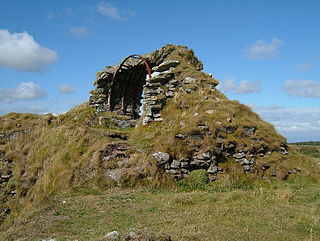 W
WCruggleton Castle is a multi-period archaeological site on the coast of the Machars, in the historical county of Wigtownshire in south-west Scotland. It is located at Cruggleton Point, around 4.5 kilometres (2.8 mi) east of Whithorn and 6 kilometres (3.7 mi) south-east of Sorbie. Excavations in the 1970s and 1980s revealed several periods of use, from the 1st century AD to the 17th century. The first stone tower was built in the 13th century, on an earlier motte.
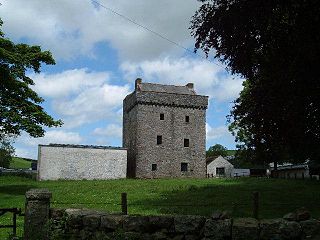 W
WDrumcoltran Tower is a late-16th-century tower house situated in the historical county of Kirkcudbrightshire near Kirkgunzeon, Dumfries and Galloway.
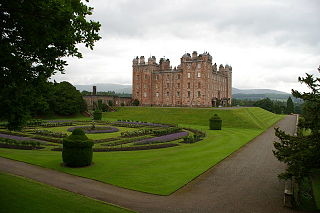 W
WDrumlanrig Castle is situated on the Queensberry Estate in Dumfries and Galloway, Scotland. The category A listed castle is the Dumfriesshire home of the Duke and Duchess of Buccleuch and Queensberry.
 W
WDunskey Castle is a ruined, 12th century tower house or castle, located 0.5 miles (0.80 km) south of the village of Portpatrick, Rhinns, Wigtownshire, on the south-west coast of Scotland.
 W
WEdingham Castle is a late 16th-century tower house situated near Dalbeattie, Dumfries and Galloway. It is the remains of an early tower house built for the Livingstones of Little Airds. It is near Edingham Munitions Factory and is a scheduled ancient monument.
 W
WFriars' Carse is a mansion house and estate situated 2 kilometres (1.2 mi) southeast of Auldgirth on the main road (A76) to Dumfries, Parish of Dunscore, Scotland. The property is located on the west bank of the River Nith and is known for its strong associations with Robert Burns who lived for a while at the nearby Ellisland farm. The mansion house is unlisted, however the stables and hermitage are Category B listed buildings.
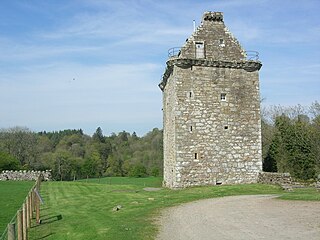 W
WGilnockie Tower is a 16th-century tower house, located at the hamlet of Hollows, 2.3 km north of Canonbie, in Dumfries and Galloway, south-west Scotland. The tower is situated on the west bank of the River Esk. It was originally known as Hollows Tower.
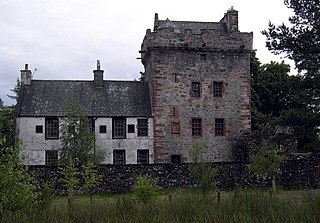 W
WHills Tower is a sixteenth-century square tower house, with an adjoining eighteenth-century wing, near Dumfries in Scotland. Originally built around 1527 for Edward Maxwell, who had purchased the estate from James Douglas of Drumlanrig, it was improved in the later sixteenth century by his grandson, also Edward Maxwell. In 1721, another Edward Maxwell had a two-storey Georgian wing added to the tower's east side, using stone taken from older buildings nearby, and incorporating armorial panels celebrating members of the Maxwell family.
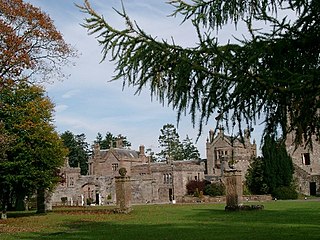 W
WHoddom Castle is a large tower house in Dumfries and Galloway, south Scotland. It is located by the River Annan, 4 kilometres (2.5 mi) south-west of Ecclefechan and the same distance north-west of Brydekirk in the parish of Cummertrees. The castle is protected as a category A listed building.
 W
WIsle of Whithorn is one of the most southerly villages and seaports in Scotland, lying on the coast north east of Burrow Head, about three miles from Whithorn and about thirteen miles south of Wigtown in Dumfries and Galloway. Whithorn,, is a former royal burgh in Wigtownshire, Dumfries and Galloway, with which Isle of Whithorn is frequently incorrectly amalgamated or confused. It is referred to locally as 'The Isle' - never 'the Isle of Whithorn'.
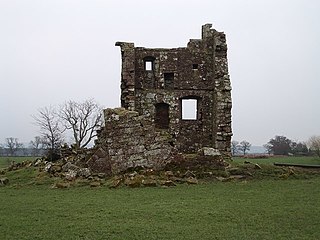 W
WIsle Tower also known as Lochar Tower and Bankend Tower is a 16th-century ruined tower house located in the north of Bankend. It was a property of the Maxwell family.
 W
WKenmure Castle is a fortified house or castle in The Glenkens, 1 mile (1.6 km) south of the town of New Galloway in Kirkcudbrightshire, Galloway, south-west Scotland. The site was occupied from the Middle Ages, and the house incorporates part of a 17th-century castle. This was remodelled in the 19th century, but the house has been derelict since the mid-20th century. It was the seat of the Gordon family of Lochinvar, later raised to the peerage as Viscounts of Kenmure. The ruin is a scheduled monument.
 W
WLochhouse Tower is a mid-16th-century tower house situated near Moffat, Dumfries and Galloway. It was restored in the late 1970s and is now used as a private residence.
 W
WLochinvar is a loch in the civil parish of Dalry in the historic county of Kirkcudbrightshire, Dumfries and Galloway Scotland. It is located in the Galloway Hills, around 3.5 miles (5.6 km) north-east of St. John's Town of Dalry. The loch formerly had an island on which stood Lochinvar Castle, seat of the Gordon family. In the 20th century the loch was dammed to form a reservoir, raising the water level and submerging the island with the ruins of the castle. The loch is used for trout fishing.
 W
WLochmaben Castle is a ruined castle in the town of Lochmaben, the feudal Lordship of Annandale, and the united county of Dumfries and Galloway. It was built by Edward I in the 13th and 14th centuries, and later rebuilt during the reign of James IV of Scotland. An earlier motte-and-bailey castle was built south of the current castle in c. 1160 by the Bruce family, Lords of Annandale.
 W
WLochnaw Castle is a 16th-century tower house five miles from the town of Stranraer, in the historical county of Wigtownshire. Scotland. The spectacularly located "castle" incorporates a fortalice torhous. The "central" square tower 5 stories high formed part of the "New" Castle.
 W
WLochwood Tower, also known as Lochwood Castle, is a ruined 16th-century L-plan tower house, about 6 miles (9.7 km) south of Moffat, Dumfries and Galloway, Scotland.
 W
WMorton Castle is located by an artificial loch in the hills above Nithsdale, in Dumfries and Galloway, south-west Scotland. It lies 2.5 miles (4 km) north-east of Thornhill, and once formed part of a chain of castles along the strategically important Nith Valley, which runs from the Solway Firth north to the Clyde Valley.
 W
WThe site of the old Newbie Castle, Newbay Castle or Newby Castle was the caput of the Barony of Newbie near Annan close to the River Annan's confluence with the Solway Firth in Dumfries and Galloway, Scotland. Held by the Corries and then the Johnstones. Newbie Harbour on the River Annan was located nearby.
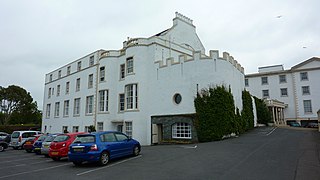 W
WNorth West Castle is a 19th-century four star country house hotel in Stranraer, Dumfries and Galloway, in the south west of Scotland.
 W
WOrchardton Castle overlooks the Solway Coast. Built around a Scottish Baronial-style mansion located in Auchencairn in the historical county of Kirkcudbrightshire in Dumfries and Galloway in Scotland. It overlooks the Solway Firth, with views to Cumbria and Hestan Island.
 W
WOrchardton Tower is a ruined tower house in Kirkcudbrightshire, Dumfries and Galloway, Scotland. It is located 4 miles (6.1 km) south of Dalbeattie, and 1 mile (1.7 km) south of Palnackie, in Buittle parish. It is remarkable as the only cylindrical tower house in Scotland. Orchardton Tower is in the care of Historic Environment Scotland as a Scheduled Ancient Monument.
 W
WThe Castle of Park is a 16th-century L-plan tower house near Glenluce, in the historic county of Wigtownshire in Dumfries and Galloway, Scotland. It is a category A listed building.
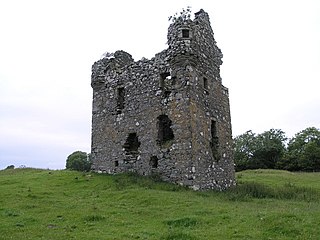 W
WPlunton Castle is a ruined L-plan tower house between Kirkandrews and Gatehouse of Fleet in Dumfries and Galloway, Scotland. Built around 1575 for the Lennoxes of Plunton, it passed by marriage to the Murrays of Broughton in the late 17th century. It was still inhabited in 1684, when it was described by Reverend Symson in his Large Description of Galloway as "a good strong house", but by 1838, when it was painted by George Colomb, it had been abandoned and had fallen into a ruinous condition.
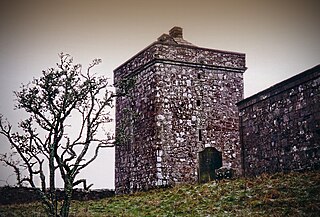 W
WThe Repentance Tower is a very rare example of a mid-16th century watch tower standing on Trailtrow Hill, six miles north-west of Annan, Dumfries and Galloway. Built in 1565 by John Maxwell, the tower takes its name from an inscription Repentance carved on the stonework above the entrance door.
 W
WRobgill Tower is a tower house near Ecclefechan on the banks of the river Kirtle. It was one of a number of towers built along the border as protection against incursions by the British.
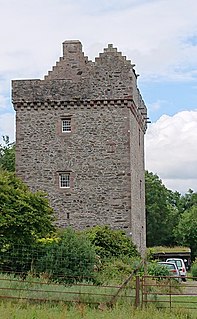 W
WRusco Tower, sometimes called Rusco Castle, is a tower house near Gatehouse of Fleet in Dumfries and Galloway, Scotland. Built around 1500 for Mariota Carson and her husband Robert Gordon, on lands given to them by her father, it was used to incarcerate a number of the Gordons' rivals in the 16th century. After Robert Gordon died and Carson remarried, their eldest son James Gordon seized the tower and imprisoned his mother, fearing that she would make it over to her new husband, Thomas Maclellan of Bombie. Gordon went on to kill Maclellan on the High Street in Edinburgh, while a court case intended to settle the matter was ongoing.
 W
WSanquhar Castle, now a ruin, was built by the Crichton family in the 13th century. Situated on the southern approach to the former royal burgh of Sanquhar in Dumfries and Galloway, south west Scotland, it sits on the trail of the Southern Upland Way, and is passed by hundreds of visitors who walk through the grounds each year.
 W
WSorbie Tower is a fortified tower house 1 mile east of the village of Sorbie, Dumfries and Galloway, Scotland.
 W
WThe Castle of St John is an early 16th-century L-plan tower house in the centre of Stranraer, in Dumfries and Galloway, southwest Scotland. It was built by the Adairs of Kilhilt c.1510. It has been used as a home, a court, a police station and as a military garrison during the "Killing Times" of Covenanter persecution in the 1680s. During the Victorian era, the castle was modified to serve as a prison, and it was used as an ARP base during the Second World War. The castle was refurbished in the late 1980s and is now a museum.
 W
WThreave Castle is situated on an island in the River Dee, 2.5 kilometres (1.6 mi) west of Castle Douglas in the historical county of Kirkcudbrightshire in the Dumfries and Galloway region of Scotland.
 W
WTibbers Castle is a motte-and-bailey castle overlooking a ford across the River Nith in Dumfries and Galloway, Scotland. To the east is the village of Carronbridge and to the north west is a 16th-century country house, Drumlanrig Castle.
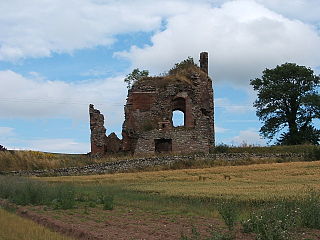 W
WTorthorwald Castle is a large ruined rectangular tower at the centre of the village of Torthorwald just outside Dumfries in south west Scotland. The first castle on the site was an earthwork motte-and-bailey built in the 12th century. The earliest building which forms part of the current ruins was built in the 14th century.